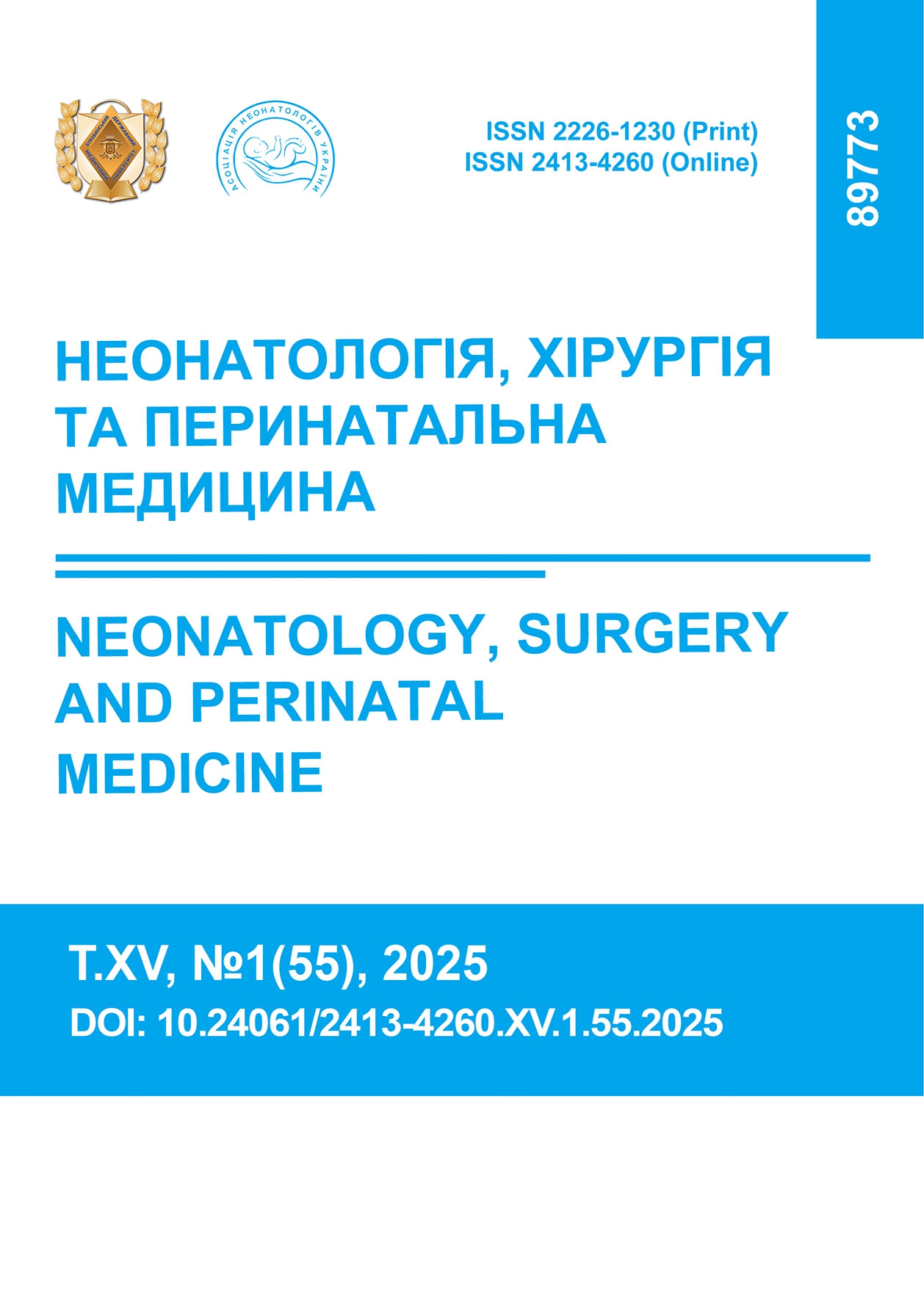ФУНКЦІЇ ТА ОКРЕМІ МЕХАНІЗМИ ВПЛИВУ BIFIDOBACTERIA НА СТАН ЗДОРОВ’Я НЕМОВЛЯТ
DOI:
https://doi.org/10.24061/2413-4260.XV.1.55.2025.23Ключові слова:
мікробна колонізація; немовлята; bifidobacteriaАнотація
Біфідобактерії є членами кишкової мікробіоти людини, а деякі штами здатні чинити оздоровчий вплив. Рід Bifidobacterium належить до актинобактерій (Actinobacteria phylum). Firmicutes, Bacteroidetes та Actinobacteria складають найчисленнішу філу в мікробіоті кишечника людини, причому Firmicutes та Bacteroidetes переважають у дорослих, а Actinobacteria - у немовлят на грудному вигодовуванні, де біфідобактерії можуть досягати рівня, що перевищує 90% від загальної бактеріальної популяції. Вони є одними з перших мікробних колонізаторів кишечника новонароджених і відіграють ключову роль у розвитку їхньої фізіології, включаючи дозрівання імунної системи та використання харчових компонентів. Дійсно, деякі поживні речовини, такі як олігосахариди людського молока, є важливими факторами розвитку біфідобактерій. Наразі існують добре задокументовані наукові докази ефективності препаратів, що містять біфідобактерії, при деяких кишкових та позакишкових патологіях. У цьому огляді ми зосередимося на ролі біфідобактерій як членів кишкової мікробіоти людини та їх застосуванні як пробіотиків для профілактики та лікування захворювань.
Посилання
Tojo R, Suárez A, Clemente MG, de los Reyes-Gavilán CG, Margolles A, Gueimonde M, Ruas-Madiedo P. Intestinal microbiota in health and disease: role of bifidobacteria in gut homeostasis. World J Gastroenterol. 2014;20(41):15163-76. DOI: http://doi.org/10.3748/wjg.v20.i41.15163 PMID: 25386066; PMCID: PMC4223251.
Reid G, Younes JA, Van der Mei HC, Gloor GB, Knight R, Busscher HJ. Microbiota restoration: natural and supplemented recovery of human microbial communities. Nat Rev Microbiol. 2011;9(1):27-38. DOI: http://doi.org/10.1038/nrmicro2473 PMID: 21113182.
FAO/WHO. Probiotics in Food: Health and Nutritional Properties and Guidelines for Evaluation. FAO Food and Nutrition Paper 85. Food and Agriculture Organization of the United Nations, World Health Organization, Rome; 2006. 56 p. Available from: http://www.fao.org/3/a-a0512e.pdf
Hill C, Guarner F, Reid G, Gibson GR, Merenstein DJ, Pot B, et al. Expert consensus document. The International Scientific Association for Probiotics and Prebiotics consensus statement on the scope and appropriate use of the term probiotic. Nat Rev Gastroenterol Hepatol. 2014;11(8):506-14. DOI: http://doi.org/10.1038/nrgastro.2014.66 PMID: 24912386.
Tissier H. Traitement des infections intestinales par la méthode de la flore bactérienne de l’intestin. Crit Rev Soc Biol. 1906;60:359–61.
Moro E. Über den Bacillus acidophilus. Jahrb Kinderheilkunde Physiche Erziehung. 1900;52:38-55.
Statement on the update of the list of QPS‐recommended biological agents intentionally added to food or feed as notified to EFSA. 2: Suitability of taxonomic units notified to EFSA until March 2015. EFSA Journal. 2015;13(6):4138. DOI: http://doi.org/10.2903/j.efsa.2015.4138
Miele E, Pascarella F, Giannetti E, Quaglietta L, Baldassano RN, Staiano A. Effect of a probiotic preparation (VSL#3) on induction and maintenance of remission in children with ulcerative colitis. Am J Gastroenterol. 2009;104(2):437-43. DOI: http://doi.org/10.1038/ajg.2008.118 PMID: 19174792.
Kajander K, Myllyluoma E, Rajilić-Stojanović M, Kyrönpalo S, Rasmussen M, Järvenpää S, et al. Clinical trial: multispecies probiotic supplementation alleviates the symptoms of irritable bowel syndrome and stabilizes intestinal microbiota. Aliment Pharmacol Ther. 2008;27(1):48-57. DOI: http://doi.org/10.1111/j.1365-2036.2007.03542.x PMID: 17919270.
Almeida CC, Lorena SL, Pavan CR, Akasaka HM, Mesquita MA. Beneficial effects of long-term consumption of a probiotic combination of Lactobacillus casei Shirota and Bifidobacterium breve Yakult may persist after suspension of therapy in lactose-intolerant patients. Nutr Clin Pract. 2012;27(2):247-51. DOI: http://doi.org/10.1177/0884533612440289 PMID: 22402407.
Reid G. The growth potential for dairy probiotics. Int Dairy J. 2015;49:16-22. DOI: https://doi.org/10.1016/j.idairyj.2015.04.004
Marsh AJ, Hill C, Ross RP, Cotter PD. Fermented beverages with health-promoting potential: past and future perspectives. Trends Food Sci Technol. 2014;38:113-24. DOI: https://doi.org/10.1016/j.tifs.2014.05.002
Prasanna PHP, Grandison AS, Charalampopoulos D. Bifidobacteria in milk products: an overview of physiological and biochemical properties, exopolysaccharide production, selection criteria of milk products and health benefits. Food Res Int. 2014;55:247-62. DOI: https://doi.org/10.1016/j.foodres.2013.11.013
Janer C, Arigoni F, Lee BH, Peláez C, Requena T. Enzymatic ability of Bifidobacterium animalis subsp. lactis to hydrolyze milk proteins: identification and characterization of endopeptidase O. Appl Environ Microbiol. 2005;71(12):8460-5. DOI: http://doi.org/10.1128/AEM.71.12.8460-8465.2005 PMID: 16332835; PMCID: PMC1317388.
Turroni F, Foroni E, Serafini F, Viappiani A, Montanini B, Bottacini F, et al. Ability of Bifidobacterium breve to grow on different types of milk: exploring the metabolism of milk through genome analysis. Appl Environ Microbiol. 2011;77(20):7408-17. DOI: http://doi.org/10.1128/AEM.05336-11 PMID: 21856831; PMCID: PMC3194849.
Serafini F, Turroni F, Ruas-Madiedo P, Lugli GA, Milani C, Duranti S, et al. Kefir fermented milk and kefiran promote growth of Bifidobacterium bifidum PRL2010 and modulate its gene expression. Int J Food Microbiol. 2014;178:50-9. DOI: http://doi.org/10.1016/j.ijfoodmicro.2014.02.024 PMID: 24667318.
Hickey CD, Sheehan JJ, Wilkinson MG, Auty MA. Growth and location of bacterial colonies within dairy foods using microscopy techniques: a review. Front Microbiol. 2015;6:99. DOI: http://doi.org/10.3389/fmicb.2015.00099 PMID: 25741328; PMCID: PMC4332360.
de los Reyes-Gavilán CG, Suárez A, Fernández-García M, Margolles A, Gueimonde M, Ruas-Madiedo P. Adhesion of bile-adapted Bifidobacterium strains to the HT29-MTX cell line is modified after sequential gastrointestinal challenge simulated in vitro using human gastric and duodenal juices. Res Microbiol. 2011;162(5):514-9. DOI: http://doi.org/10.1016/j.resmic.2011.03.009 PMID: 21419219.
Hidalgo-Cantabrana C, Delgado S, Ruiz L, Ruas-Madiedo P, Sánchez B, Margolles A. Bifidobacteria and Their Health-Promoting Effects. Microbiol Spectr. 2017;5(3):10.1128/microbiolspec.bad-0010-2016. DOI: http://doi.org/10.1128/microbiolspec.BAD-0010-2016 PMID: 28643627; PMCID: PMC11687494.
Gonzalez-Gonzalez C, Gibson T, Jauregi P. Novel probiotic-fermented milk with angiotensin I-converting enzyme inhibitory peptides produced by Bifidobacterium bifidum MF 20/5. Int J Food Microbiol. 2013;167(2):131-7. DOI: http://doi.org/10.1016/j.ijfoodmicro.2013.09.002 PMID: 24135669.
Lewis ZT, Shani G, Masarweh CF, Popovic M, Frese SA, Sela DA, et al. Validating bifidobacterial species and subspecies identity in commercial probiotic products. Pediatr Res. 2016;79(3):445-52. DOI: http://doi.org/10.1038/pr.2015.244 PMID: 26571226; PMCID: PMC4916961.
López P, de Paz B, Rodríguez-Carrio J, Hevia A, Sánchez B, Margolles A, et al. Th17 responses and natural IgM antibodies are related to gut microbiota composition in systemic lupus erythematosus patients. Sci Rep. 2016;6:24072. DOI: http://doi.org/10.1038/srep24072 PMID: 27044888; PMCID: PMC4820712.
He T, Priebe MG, Zhong Y, Huang C, Harmsen HJ, Raangs GC, et al. Effects of yogurt and bifidobacteria supplementation on the colonic microbiota in lactose-intolerant subjects. J Appl Microbiol. 2008;104(2):595-604. DOI: http://doi.org/10.1111/j.1365-2672.2007.03579.x PMID: 17927751.
Weizman Z, Asli G, Alsheikh A. Effect of a probiotic infant formula on infections in child care centers: comparison of two probiotic agents. Pediatrics. 2005;115(1):5-9. DOI: http://doi.org/10.1542/peds.2004-1815 PMID: 15629974.
Corrêa NB, Péret Filho LA, Penna FJ, Lima FM, Nicoli JR. A randomized formula controlled trial of Bifidobacterium lactis and Streptococcus thermophilus for prevention of antibiotic-associated diarrhea in infants. J Clin Gastroenterol. 2005;39(5):385-9. DOI: http://doi.org/10.1097/01.mcg.0000159217.47419.5b PMID: 15815206.
Selinger CP, Bell A, Cairns A, Lockett M, Sebastian S, Haslam N. Probiotic VSL#3 prevents antibiotic-associated diarrhoea in a double-blind, randomized, placebo-controlled clinical trial. J Hosp Infect. 2013;84(2):159-65. DOI: http://doi.org/10.1016/j.jhin.2013.02.019 PMID: 23618760.
Goldenberg JZ, Yap C, Lytvyn L, Lo CK, Beardsley J, Mertz D, et al. Probiotics for the prevention of Clostridium difficile-associated diarrhea in adults and children. Cochrane Database Syst Rev. 2017;12(12):CD006095. DOI: http://doi.org/10.1002/14651858.CD006095.pub4 PMID: 29257353; PMCID: PMC6486212.
Toh ZQ, Anzela A, Tang ML, Licciardi PV. Probiotic therapy as a novel approach for allergic disease. Front Pharmacol. 2012;3:171. DOI: http://doi.org/10.3389/fphar.2012.00171 PMID: 23049509; PMCID: PMC3448073.
Sistek D, Kelly R, Wickens K, Stanley T, Fitzharris P, Crane J. Is the effect of probiotics on atopic dermatitis confined to food sensitized children? Clin Exp Allergy. 2006;36(5):629-33. DOI: http://doi.org/10.1111/j.1365-2222.2006.02485.x PMID: 16650048.
Gerasimov SV, Vasjuta VV, Myhovych OO, Bondarchuk LI. Probiotic supplement reduces atopic dermatitis in preschool children: a randomized, double-blind, placebo-controlled, clinical trial. Am J Clin Dermatol. 2010;11(5):351-61. DOI: http://doi.org/10.2165/11531420-000000000-00000 PMID: 20642296.
van der Aa LB, Heymans HS, van Aalderen WM, Sillevis Smitt JH, Knol J, Ben Amor K, et al. Effect of a new synbiotic mixture on atopic dermatitis in infants: a randomized-controlled trial. Clin Exp Allergy. 2010;40(5):795-804. DOI: http://doi.org/10.1111/j.1365-2222.2010.03465.x PMID: 20184604.
Singh A, Hacini-Rachinel F, Gosoniu ML, Bourdeau T, Holvoet S, Doucet-Ladeveze R, et al. Immune-modulatory effect of probiotic Bifidobacterium lactis NCC2818 in individuals suffering from seasonal allergic rhinitis to grass pollen: an exploratory, randomized, placebo-controlled clinical trial. Eur J Clin Nutr. 2013;67(2):161-7. DOI: http://doi.org/10.1038/ejcn.2012.197 PMID: 23299716.
Huurre A, Laitinen K, Rautava S, Korkeamäki M, Isolauri E. Impact of maternal atopy and probiotic supplementation during pregnancy on infant sensitization: a double-blind placebo-controlled study. Clin Exp Allergy. 2008;38(8):1342-8. DOI: http://doi.org/10.1111/j.1365-2222.2008.03008.x PMID: 18477013.
Dotterud CK, Storrø O, Johnsen R, Oien T. Probiotics in pregnant women to prevent allergic disease: a randomized, double-blind trial. Br J Dermatol. 2010 Sep;163(3):616-23. DOI: http://doi.org/10.1111/j.1365-2133.2010.09889.x PMID: 20545688.
Wickens K, Black PN, Stanley TV, Mitchell E, Fitzharris P, Tannock GW, et al. A differential effect of 2 probiotics in the prevention of eczema and atopy: a double-blind, randomized, placebo-controlled trial. J Allergy Clin Immunol. 2008;122(4):788-94. DOI: http://doi.org/10.1016/j.jaci.2008.07.011 PMID: 18762327.
Kim JY, Kwon JH, Ahn SH, Lee SI, Han YS, Choi YO, et al. Effect of probiotic mix (Bifidobacterium bifidum, Bifidobacterium lactis, Lactobacillus acidophilus) in the primary prevention of eczema: a double-blind, randomized, placebo-controlled trial. Pediatr Allergy Immunol. 2010;21(2 Pt 2):e386-93. DOI: http://doi.org/10.1111/j.1399-3038.2009.00958.x PMID: 19840300.
Niers L, Martín R, Rijkers G, Sengers F, Timmerman H, van Uden N, et al. The effects of selected probiotic strains on the development of eczema (the PandA study). Allergy. 2009;64(9):1349-58. DOI: http://doi.org/10.1111/j.1398-9995.2009.02021.x PMID: 19392993.
##submission.downloads##
Опубліковано
Як цитувати
Номер
Розділ
Ліцензія

Ця робота ліцензується відповідно до Creative Commons Attribution 4.0 International License.
Автори, які публікуються у цьому журналі, погоджуються з наступними умовами:
- Автори залишають за собою право на авторство своєї роботи та передають журналу право першої публікації цієї роботи на умовах ліцензії Creative Commons Attribution License, котра дозволяє іншим особам вільно розповсюджувати опубліковану роботу з обов'язковим посиланням на авторів оригінальної роботи та першу публікацію роботи у цьому журналі.
- Автори мають право укладати самостійні додаткові угоди щодо неексклюзивного розповсюдження роботи у тому вигляді, в якому вона була опублікована цим журналом (наприклад, розміщувати роботу в електронному сховищі установи або публікувати у складі монографії), за умови збереження посилання на першу публікацію роботи у цьому журналі.
- Політика журналу дозволяє і заохочує розміщення авторами в мережі Інтернет (наприклад, у сховищах установ або на особистих веб-сайтах) рукопису роботи, як до подання цього рукопису до редакції, так і під час його редакційного опрацювання, оскільки це сприяє виникненню продуктивної наукової дискусії та позитивно позначається на оперативності та динаміці цитування опублікованої роботи (див. The Effect of Open Access).
Критерії авторського права, форми участі та авторства
Кожен автор повинен був взяти участь в роботі, щоб взяти на себе відповідальність за відповідні частини змісту статті. Один або кілька авторів повинні нести відповідальність в цілому за поданий для публікації матеріал - від моменту подачі до публікації статті. Авторитарний кредит повинен грунтуватися на наступному:
- істотність частини вклада в концепцію і дизайн, отри-мання даних або в аналіз і інтерпретацію результатів дослідження;
- написання статті або критичний розгляд важливості її інтелектуального змісту;
- остаточне твердження версії статті для публікації.
Автори також повинні підтвердити, що рукопис є дійсним викладенням матеріалів роботи і що ні цей рукопис, ні інші, які мають по суті аналогічний контент під їх авторством, не були опубліковані та не розглядаються для публікації в інших виданнях.
Автори рукописів, що повідомляють вихідні дані або систематичні огляди, повинні надавати доступ до заяви даних щонайменше від одного автора, частіше основного. Якщо потрібно, автори повинні бути готові надати дані і повинні бути готові в повній мірі співпрацювати в отриманні та наданні даних, на підставі яких проводиться оцінка та рецензування рукописи редактором / членами редколегії журналу.
Роль відповідального учасника.
Основний автор (або призначений відповідальний автор) буде виступати від імені всіх співавторів статті в якості основного кореспондента при листуванні з редакцією під час процесу її подання та розгляду. Якщо рукопис буде прийнята, відповідальний автор перегляне відредагований машинописний текст і зауваження рецензентів, прийме остаточне рішення щодо корекції і можливості публікації представленої рукописи в засобах масової інформації, федеральних агентствах і базах даних. Він також буде ідентифікований як відповідальний автор в опублікованій статті. Відповідальний автор несе відповідальність за подтверждленіе остаточного варіанта рукопису. Відповідальний автор несе також відповідальність за те, щоб інформація про конфлікти інтересів, була точною, актуальною і відповідала даним, наданим кожним співавтором.Відповідальний автор повинен підписати форму авторства, що підтверджує, що всі особи, які внесли істотний внесок, ідентифіковані як автори і що отримано письмовий дозвіл від кожного учасника щодо публікації представленої рукописи.
















